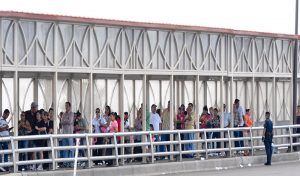by Okan Gurbuz
In the past year, the world has undergone an immense transformation in an attempt to slow the spread of COVID-19. Complete lockdowns and curfews have been enacted and then lifted to balance mitigating the spread of the disease with keeping economies working. Although a lot is still unknown about COVID-19, one thing is certain: transportation is one way the disease is spread from place to place.
We’ve also seen how the pandemic can be lessened in countries limiting non-essential travel and recommending citizens stay at home whenever possible. But international trade and the travel associated with it can’t be suspended indefinitely, pointing up the need to understand how cross-border movement can facilitate the spread of the disease—and infectious diseases in general—between communities.
Better understanding this relationship holds significant implications for cross-border trade and tourism, both of which are primary contributors to the U.S. and Mexican economies. Although international travel may seem like it’s easy to control, everyday life in large population centers (for example, workers crossing the border to get to their jobs) make it increasingly difficult to contain. That makes understanding cross-border travel a key concern in predicting viral outbreaks in border communities.

International trade and the travel associated with it can’t be suspended indefinitely. That’s why we need to understand how cross-border movement can facilitate the spread of the disease—and infectious diseases in general—between communities.
I and my team at the Texas A&M Transportation Institute’s (TTI’s) Center for International Intelligent Transportation Research (CIITR) are currently studying this issue. After collecting border mobility data, we developed macro-econometric models to show how factors (such as number of daily pedestrian and passenger crossings) might affect the spread of COVID-19 in the El Paso-Ciudad Juárez region. These models helped our team identify technologies and strategies to measure and track the spread of the disease.
Decision-makers can use our recommendations regarding these technologies and strategies to better prepare for future outbreaks. Reacting in a timely way to outbreaks is key to containing them, as well as help determine necessary societal restrictions such as curfews and lockdowns.
Preliminary findings suggest that shared borders between the United States and Mexico are more likely to have a higher spread rate of COVID-19. An analysis of infections showed that communities with border crossings doubled in the number of average cases per 1,000 population compared to communities without border crossings in both the United States (16.2 vs. 7.3, respectively) and Mexico (3.6 vs. 1.6, respectively). I and my team are planning to follow up this research by exploring the impacts of border restrictions, mitigation measures and potential contact tracing strategies by developing a specialized spread-of-disease model.
The COVID-19 pandemic has prompted researchers in multiple disciplines to dig a bit deeper to find answers related to its spread. This has certainly been the case in transportation as well, where thought leaders like the Transportation Research Board have focused research agendas on the pandemic’s impact. Research like ours can help inform transportation planning, guide disease response measures and empower communities to stay as healthy and safe as possible.
Okan Gurbuz is an assistant research scientist in TTI’s El Paso Research and Implementation Office.

